Is Meditation a Unique State?
Is Meditation Just a Form of Self-Hypnosis?
, Ph.D.
Author of “The Book of Meditation”
I’m often asked whether meditation and hypnosis is not the ‘same thing’ because they both involve entering a ‘trance state’. The word ‘trance’ often brings a negative image to mind. According to Webster’s Dictionary, it implies an inability to function or being in a state of daze or stupor. It is also frequently thought of in the sense of the trances of deep hypnosis, where a person has only limited contact with her surroundings and may be quite unable, afterward, to recall what went on during the trance.
These are certain kinds of trance, to be sure, but in actual fact they are neither the only ones nor the most prevalent. Light trance states, which are familiar to everyone, do not ordinarily possess these alarming qualities. Dr Ronald Shor, a specialist in hypnosis, has pointed out that these light trances are actually daily, commonplace occurrences for all of us.1 They involve sharp narrowing of our attention, which becomes focused on one or on a few objects or events or thoughts. Because of this narrowing of attention, our generalized reality-orientation – that is, our awareness of our surroundings and of our usual ways of thinking and perceiving – begins to fade, creating a ‘trance’ effect. Shor describes his own experience with such a spontaneous trance:
I was reading a rather difficult scientific book which required complete absorption of thought to follow the argument. I had lost myself in it and was unaware of the passage of time or my surroundings. Then without warning, something was intruding upon me; a vague, nebulous feeling of change. It all took place in a split second and when it was over I discovered that my wife had entered the room and had addressed a remark to me. I was then able to call forth the remark itself which had somehow etched itself into my memory even though at the time it was spoken I was not aware of it.2
Obviously many other everyday occurrences involve entering a state of light trance, although we may not label the state we experience by that name. We all know, for example, how artists may be intensely absorbed in their work during its inspirational phase and become practically oblivious to their surroundings. The same absorption can occur when one is deeply involved in some majestic scene or in an engrossing game, or in viewing a work of art, listening to music, making love . . . or meditating. Does this mean that we should think of all these activities as being forms of self-hypnosis?
Although both meditation and self-hypnosis involve some degree of trance, there are also some important differences between them. One of the identifying characteristics of self hypnosis is the increased receptiveness of subjects to self administered suggestions about mental or physical behavior which they want to bring about. The hypnotized person acts (or thinks) in the way he believes the hypnotist or he himself is directing him to act.
Self-hypnosis is therefore goal-directed, and psychologist Robert White, discussing the theory of hypnotism, has suggested that goal-directed striving is one of the primary characteristics of all hypnotic states.3
This description of hypnosis is very different from most descriptions of meditation. In the great traditions, meditation is looked upon as a goal-less, non-striving state. Although in actual practice the meditator may make some effort during meditation (perhaps in an attempt to reach some spiritual goal), this is usually only a minor aspect of the experience and is often discouraged by meditation teachers. Self-suggestions such as telling oneself to relax during meditation, or the implied ‘suggestion’ involved in repeating a mantra which has become a signal to oneself to enter a state of deep relaxation, do of course play some role in the meditative experience. Certain forms of Yoga also require the meditator to employ some suggestions to help her reach Brahman, the highest state of consciousness, but these minor uses of suggestion can scarcely be compared to the central position given to suggestion in self hypnosis. With respect to active striving toward a goal during the process itself (although not ultimately since meditators as well as hypnotic subjects typically have long-range goals) these two states seem very different.
Meditation and self-hypnosis do not necessarily show the same kinds of physiological change either. As we shall see in the next chapter, meditation typically brings about a lowering of metabolism, a deep quietness of mind and body. By contrast, some hypnotic states raise metabolism, as when an athlete uses self-hypnosis before a game to ‘psych’ himself up. Other hypnotic states bring about no physiological changes at all, including no changes in brain waves, 4 and a number of researchers have shown that hypnotized subjects usually have an activated brain-wave pattern, which is no different from ordinary wakefulness.5 The only time hypnotized persons show wave patterns similar to those seen during meditation is when they are given specific suggestions to enter a meditation-like state. If they are directed to become deeply relaxed, they will usually obligingly do so, just as they will do many other things, including going to sleep, under hypnosis.*
The relationship between meditation and hypnosis is not entirely solved, however. It is possible that in the broadest sense of the term, meditation is a form of ‘hypnosis’, although it is certainly not the kind most of us in the West know.
• It is interesting to note that Zen monks are taught to suppress the hypnotic trance. The name they give to it is sanran (meaning ‘confusion’), because they feel that it interferes with their practice of meditation.6
Western hypnosis is a highly motivated state where the subject plays a ‘role’, acting out certain prescribed actions or thoughts. Abraham Maslow,7 who has called this Western form ‘striving hypnosis’, points out that a much less familiar type, ‘being hypnosis’, allows the subject to move away from role-playing and enter an intense absorption similar to that of ‘peak experiences’ or mystic states of contemplation. This being-hypnosis is used almost exclusively for certain spiritual disciplines such as Yoga or Zen. It is possible that it is a form of meditation, or vice versa.
Because striving-hypnosis and meditation, while not the same thing, do have some points in common, however, it is perhaps not surprising that one of the most prominent of all the modem relaxation techniques, autogenic training, had its origin in the study of hypnosis as practiced in the West.
1. R. E. Shor, ‘Hypnosis and the Concept of the Generalized Reality Orientation’, in Altered States of Consciousness, ed. C. T. Tart (New York: Wiley, 1969), pp. 233–50.
2. Ibid, p. 241.
3. R. White, ‘A Preface to a Theory of Hypnotism’, Journal of Abnormal and Social Psychology, 36 (1941), pp. 477–506.
4. N. Kleitman, Sleep and Wakefulness (Chicago: University of Chicago Press, 1963), pp. 329–38.
5. L. Cheitok and P. Kramarz, ‘Hypnosis, Sleep and Electroencephalography’, Journal of Nervous and Mental Disease, 128 (1959), pp. 227–38; A. L. Loomis, E. N. Harvey and C. A. Hobart, ‘Electrical Potentials of the Human Brain’, Journal of Experimental Physiology, 19 (1936), pp. 249–79; J. B. Dynes, ‘Objective Method for Distinguishing Sleep from the Hypnotic Trance’, Archives of Neurology and Psychiatry, 57 (1947), pp. 84–93; A. Kasamatsu and T. Hirai, ‘An Electroencephalographic Study on the Zen Meditation (Zazen)’, in Tart (ed.), op. cit., pp. 489–501.
6. A. Kasamatsu and T. Hirai, ‘An Electroencephalographic Study on the Zen Meditation (Zazen)’, in Tart (ed.), op. cit., pp. 489–501.Maslow, as quoted in Shor, op. cit., p. 249.
Dr. Patricia Carrington's award winning meditation technique CSM (Clinically Standardized Meditation) is a clinically sensitive meditation method developed by the Medical Department of New York Telephone Company and used by numerous medical institutions, organizations, and individuals worldwide. For information .



